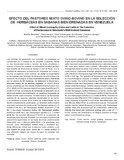| dc.rights.license | http://creativecommons.org/licenses/by-nc-sa/3.0/ve/ | es_VE |
| dc.contributor.author | Martiña Morantes, Pablo Herrera | |
| dc.contributor.author | Colmenares, Omar | |
| dc.contributor.author | Jáuregui, Damelis | |
| dc.contributor.author | Hernández-Chong, Luis | |
| dc.contributor.author | Di Martino, Giovanna | |
| dc.contributor.author | Rivas, José | |
| dc.date.accessioned | 2019-11-04T17:36:16Z | |
| dc.date.available | 2019-11-04T17:36:16Z | |
| dc.date.issued | 2019 | |
| dc.identifier.issn | 0798-2259 | |
| dc.identifier.uri | http://www.saber.ula.ve/handle/123456789/46180 | |
| dc.description.abstract | Los sistemas de producción con rumiantes en Venezuela se caracterizan por el manejo de los animales a pastoreo, donde se han incorporado ovinos y bovinos de forma simultánea o alterna, lo cual se ha realizado sin información científica de base que respalde las decisiones de manejo a nivel de fincas. Con la finalidad de determinar la selección de herbáceas por ovinos y bovinos en pastoreo mixto continuo, se realizó un experimento en las sabanas bien drenadas de Venezuela, durante la época de transición lluvia–sequía. El área experimental estuvo constituida por un potrero de 20 hectáreas. Se determinó la frecuencia y densidad relativa de las especies vegetales. El recurso animal estuvo constituido por dos mautes mestizos Brahman (peso vivo) (PV) 140,05 ± 0,78 kilogramos (kg)) y 6 borregos West African (PV 23,60 ± 0,37 kg). La selección de herbáceas se determinó con la técnica de análisis microhistólogico, en muestreos semanales de heces durante cuatro semanas. Se determinaron las frecuencias relativas de las especies vegetales identificadas en las heces, y se analizaron a través de la prueba de Kruskal-Wallis, en un diseño completamente aleatorizado. La densidad relativa mostró una mayor participación numérica del Trachypogon spicatus (L.f.) Kuntze (17,62 %) y del Trachypogon vestitus Andersson (17,33 %), y una mayor frecuencia relativa del Trachypogon vestitus Andersson (9,85 %) y del Trachypogon spicatus (L.f. ) Kuntze (8,68 %). Se encontró diferencia (P<0,01) en la selección de herbáceas entre especies animales, con una mayor frecuencia de aparición de leguminosas en las heces de ovinos, predominando Desmodium spp. y Mimosa albida Willd, y de gramíneas para bovinos, como Trachypogon vestitus Nees y Axonopus spp. Estas diferencias indican que el pastoreo mixto, continuo y con una relación de carga ovino: bovino de 1:1, puede conducir a una utilización integral del recurso forrajero en sabanas bien drenadas. | es_VE |
| dc.language.iso | es | es_VE |
| dc.publisher | SaberULA | es_VE |
| dc.rights | info:eu-repo/semantics/openAccess | es_VE |
| dc.subject | Ovino | es_VE |
| dc.subject | Bovino | es_VE |
| dc.subject | Pastoreo mixto | es_VE |
| dc.subject | Sabanas bien drenadas | es_VE |
| dc.subject | Guárico | es_VE |
| dc.subject | Venezuela | es_VE |
| dc.title | Efecto del pastoreo mixto Ovino-Bovino en la selección de herbáceas en sabanas bien drenadas en Venezuela | es_VE |
| dc.title.alternative | Effect of Mixed Grazing By Ovine and Cattle in The Selection of Herbaceous in Venezuela’s Well Drained Savannas | es_VE |
| dc.type | info:eu-repo/semantics/article | es_VE |
| dcterms.dateAccepted | 07/05/2018 | |
| dcterms.dateSubmitted | 30/11/2018 | |
| dc.description.abstract1 | The production systems with ruminants in Venezuela are characterized by the management of grazing animals, where sheep and cattle have been incorporated simultaneously or alternately, which has been done without basic scientific information to support management decisions at the level of farms. Animal resource was conformed by crossbreed Brahman weaned calves (live weight (LW) 140.05 ± 0.78 kilograms (kg)) and 6 West African lambs (LW 23.60 ± 0.37 kg). The selection of herbaceous was determined by microhistologycal analysis, in samples of feces weekly, dur- ing four weeks. The relative frequencies of the botanical species identified in feces were analyzed by Kruskal-Wallis test, as a com- pletely randomized design. Relative density showed a higher numerical participation of Trachypogon spicatus (L.f.) Kuntze (17.62 %) and Trachypogon vestitus Andersson (17.33 %), and the highest relative frequencies for Trachypogon vestitus Andersson (9.85 %) and Trachypogon spicatus (L.f.) Kuntze (8.68 %). Selection of herbaceous was different (P<0.01) between animal species, with a high frequency of legumes in ovine feces, with Desmodium spp. and Mimosa albida Willd. as predominant species. Herbaceous species had the highest frequency in bovines, with Trachypogon vestitus Nees and Axonopus spp. as predominant. Differences indicate that mixed and continuous grazing, with a ratio of 1:1 (ovine: bovine) can contribute to an integral selection of forage native in well drained savannas. | es_VE |
| dc.description.colacion | 437-444 | es_VE |
| dc.description.email | mymorantes@gmail.com | es_VE |
| dc.description.email | ocolmena@mailcity.com | es_VE |
| dc.description.email | jaureguid@gmail.com | es_VE |
| dc.description.email | rivasjoseh@gmail.com | es_VE |
| dc.identifier.depositolegal | pp199102ZU46 | |
| dc.identifier.edepositolegal | ppi201502ZU4665 | |
| dc.identifier.eissn | 2477-944X | |
| dc.publisher.pais | Venezuela | es_VE |
| dc.subject.institucion | Universidad del Zulia (LUZ) | es_VE |
| dc.subject.institucion | Universidad de Los Andes (ULA) | es_VE |
| dc.subject.keywords | Ovine | es_VE |
| dc.subject.keywords | Bovine | es_VE |
| dc.subject.keywords | Mixed grazing | es_VE |
| dc.subject.keywords | Selection | es_VE |
| dc.subject.keywords | Weii drained vannas | es_VE |
| dc.subject.keywords | Guárico | es_VE |
| dc.subject.keywords | Venezuela | es_VE |
| dc.subject.publicacionelectronica | Revista Científica | |
| dc.subject.thematiccategory | Medio Ambiente | es_VE |
| dc.subject.tipo | Revistas | es_VE |
| dc.type.media | Texto | es_VE |


